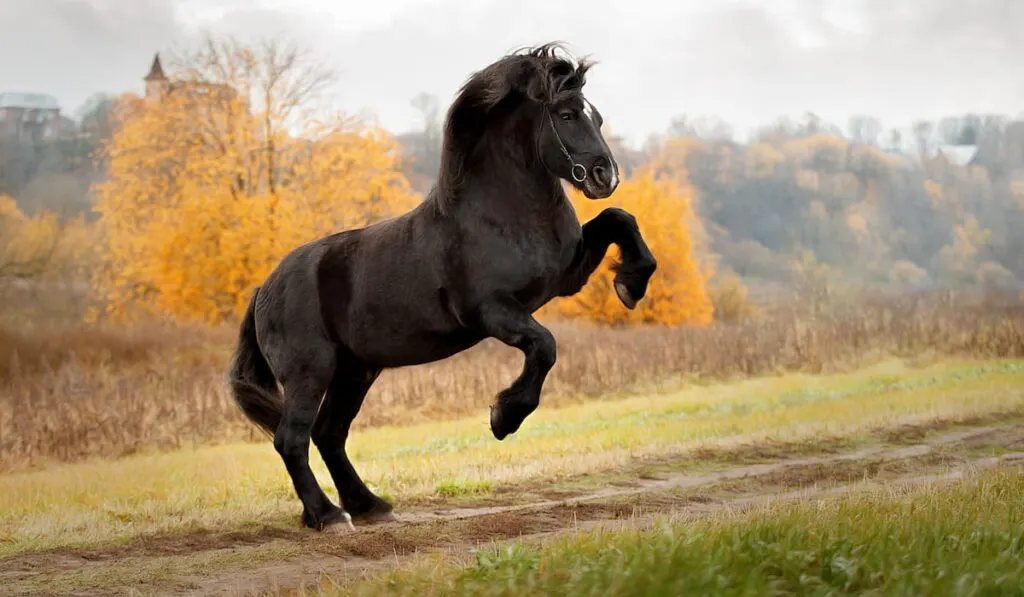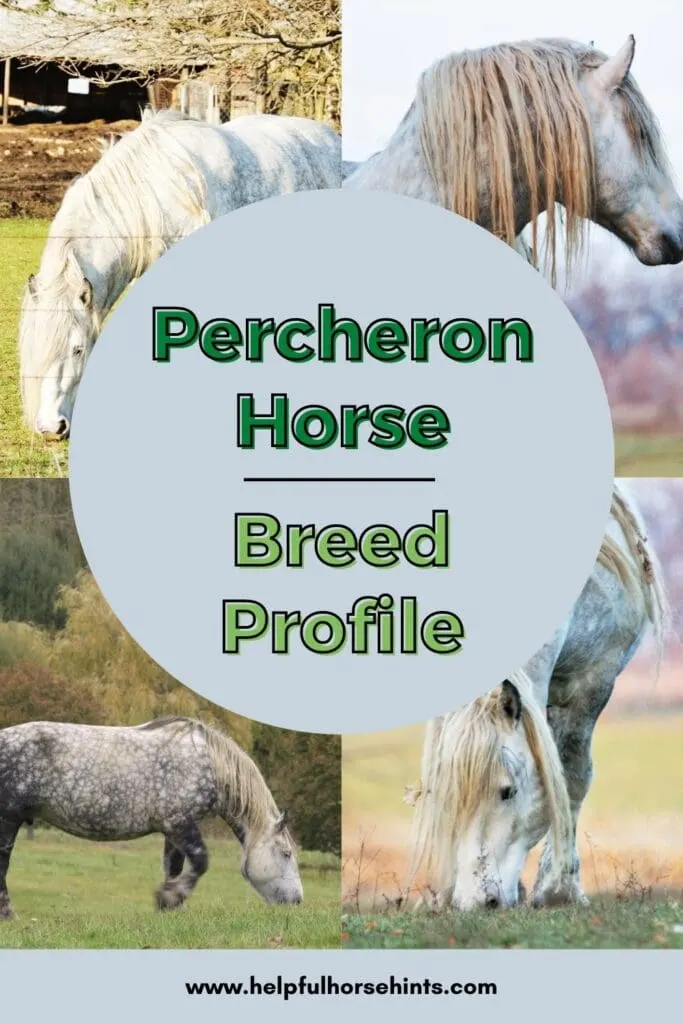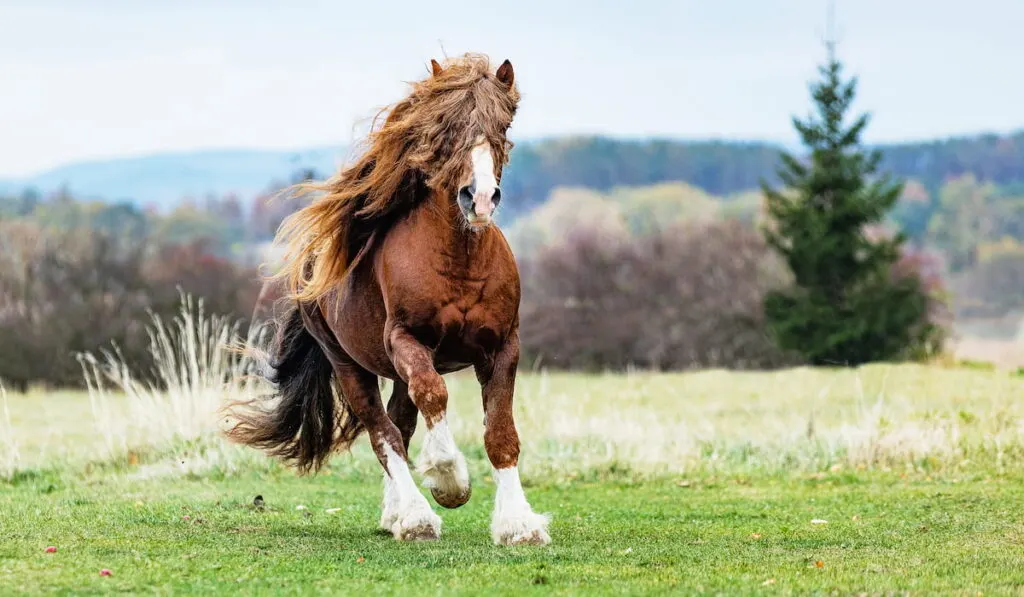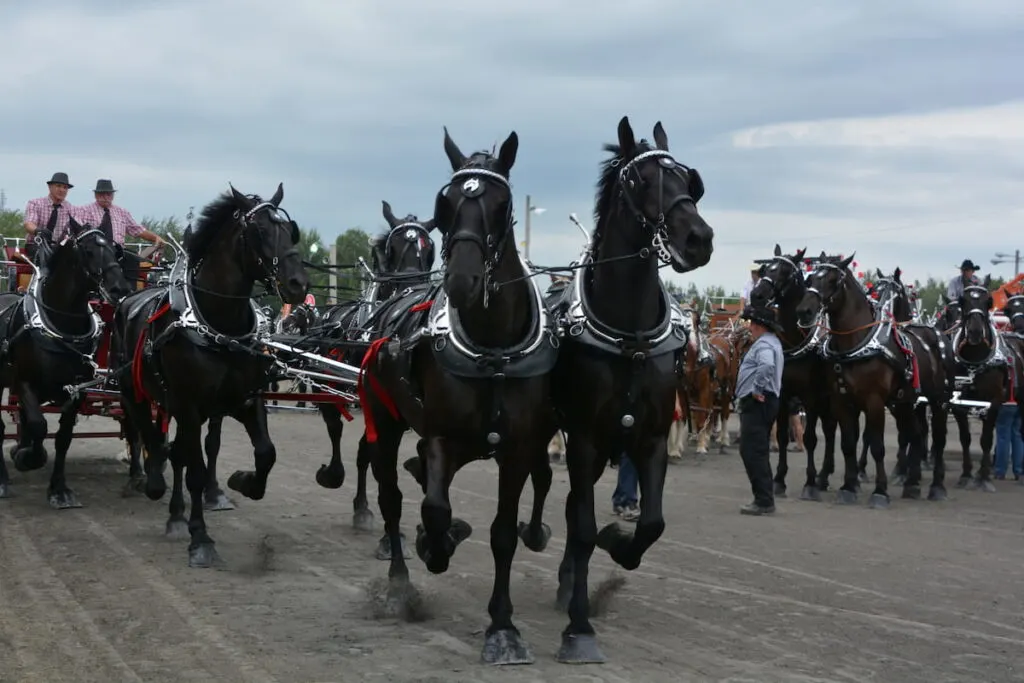As is typical of any draft horse, the Percheron is a powerful and majestic animal. Though often overlooked for the similar yet more widely known Clydesdale, the Percheron horse is a breed with a lot of history and a lot of heart.

Table of Contents
The Percheron Appearance
When you think of Percherons, think big, burly and sculpted. They are powerful horses, with particularly heavily muscled shoulders and haunches. They look almost like a taught spring, coiled and ready to explode with strength.
For all their muscular qualities, though, Percherons are still elegant and refined in their build. They have sturdy but sculpted arched necks, and faces that have a touch of an Arabian influence to them, paired with small, perky ears and flatter, wider foreheads. (source)
Their manes and tails are thick and often even have a natural waviness to them!
Height
Like many draft breeds, Percherons are tall horses, standing 16 to 17.3 hands high, and weighing anywhere from 1,800 to 2,600 pounds.
While registry standards differ from country to country, American and British registries tend to opt for weight requirements on the heavier side. Their stature is strong and their stance is alert – they’re always ready to go but not jumpy or fidgety.
Coat Colors
Percherons come in a wide variety of colors, including gray, chestnut, bay, black, roan and sorrel. The most common colors are gray or black, but American registries accept all. Of particular note, though, the only accepted French Percherons (and British) are black, gray, or those that are those born black and that fade to gray as they age. (source) Some white markings are permitted, but not to excess.

Breed Personality and Temperament Traits
Percherons are well known to be gentle giants, with a commanding presence but a docile demeanor.
Because of this, they are actually, ideal horses for beginners and children (though they may need tall mounting blocks or steps to get on their backs!) as they are very tolerant and patient.
Percherons are also easy keepers and so their daily care does not require additional or specialized knowledge. Special tack, however, will be required due to their size.
Percheron horses are known for their intelligence and their willingness to work and capacity for learning. They naturally bond with and want to please their owners and they enjoy learning new things.
Because of this, Percherons have found a role in a variety of disciplines. Plus, they are renowned for their stamina – in the 1800s, many owners would boast of the Percheron’s ability to travel almost 40 miles a day at a steady trot.
Though calm in demeanor, they are ultimately a bit more lively than some other draft horse breeds. This is most likely due in part to their crossbreeding with other, more active breeds outside of the draft genus such as warmbloods, Andalusians and Thoroughbreds.
Percheron Breed Concerns
As a sturdy horse, the Percheron is a relatively easy keeper. Thanks to their hearty nature, they aren’t particularly susceptible to health problems or major physical concerns.
The one area to take caution with, though, is their grooming. Since Percherons have heavy coats that can get packed and matted in wet, cold climates, regular brushing is a must.
Also, the thick hairs on their legs can lock in bacteria and dirt, paving the way for a painful condition caused “scratches.”
The History of the Percheron
Originating in the Perche region of France, near Normandy, it is easy to see how they got their breed name. (source) It is thought that the earliest examples of the breed were crosses between the Barbs of the Moors and the early Flemish “great horse” draft breeds of the Middle Ages. Later, Arabian horse stock was introduced into the bloodlines to add elegance and stamina.
In the 1800s, the French government started to breed Percherons as cavalry horses, since they had strong muscles, intelligent minds, and adaptive personalities. As the years went on, the Percheron expanded across Europe and was introduced internationally.
The 1870s and 1880s in particular saw countries and breeders competing to produce a commercially successful workhouse they could sell to American farmers and factories. The Percheron won that contest and by the early 1900s, the Percheron had become the most popular draft horse in America, boasting the largest number of registered horses. (source)
As a result, in America in 1876, a number of Percheron breeders met up in Chicago to form the Norman-Percheron Association. The first studbook was started, and the Percheron was the first purebred livestock association in the United States.
Then, in 1905, more Percheron breeders met again in Chicago to form the Percheron Society of America. This lasted until 1934, when the present association, the Percheron Horse Association of America, was started. Currently, there are over 3,400 members with around 2,500 new Percherons being registered each year.

As the years went on, the Percheron began to suffer the same fate as many other draft breeds, with tractors and cars replacing horses on farms and roads. The decline in breeding and buying was so dramatic that they were even on the watch list of the American Livestock Breeds Conservancy for a time. (source)
Finding a new role in pleasure riding and shows, though, the Percheron’s numbers have been on the increase, though the Conservancy still keeps an eye on their count.
Notable Percheron Horses
Born in the 1800s, the stallion Jean le Blanc is one of the most remembered and revered Percherons. He went on to be known as one of the foundations of what we know as the modern Percheron breed standards, thanks to his lengthy Percheron ancestry combined with newer Arabian bloodlines.
Around the turn of the 20th century when Percherons were at their peak as draft work and transportation horses, the Armour Packing Company stood out with their yellow wagons drawn by striking gray Percherons. They even had their company horses compete against other top working horses of the time and were featured as a main attraction in the Sells-Floto circus. (source)
So great was the Percheron’s mark on industry that in 1980, Heinz created the Heinz Percheron hitch in honor of the horse-drawn tradition. They showcased eight black Percheron horses drawing wagons and carriages in parades and at exhibitions and ceremonies.
Finally, perhaps the most famous working Percheron horses are the Pabst Brewery draft horses. Starting in the 1800s, Percherons were used to power their mills for production and then also to draw their delivery trucks in the city.
The Pabst family even owned their own stud farm, so great was their dedication to their prized Percheron line. They bred all their own stock, and many of those horses won top honors in competitions, including at the 1904 World’s Fair. (source)
Common Disciplines or Uses for Percherons

Percherons have come a long way from their original war horse roots. Not only are they excellent beginners’ horses and pleasure horses, they still have a role in the working world as well.
For example, in harness driving, many of the horses used are Percherons, thanks to their strength but compact size. That same physical capability, too, makes them ideal for the logging industry, hauling trees where larger, bulkier equipment and vehicles can’t operate.
Draft horse riders themselves are often partial to the Percheron over others. Because they are so versatile and eager to please, they are the perfect all-purpose horse, allowing riders to compete in many disciplines.
Percherons can be ridden equally as well Western as English. You can often see Percherons competing in the dressage ring, thanks to their natural elegance and their gorgeous features (including a thick, wavy mane just made for the dressage ring). Some Percherons have even conquered show jumping, despite their sturdier and somewhat less traditional sizing.
Today Percherons are still the horse of choice for parades, sleigh rides and pulling carriages. The largest team of working Percherons can be found at Disneyland Paris, where Percherons account for 30% of the horses used in the park.
Percherons are extraordinary draft horses. With striking builds, luxurious manes, sweet temperaments and active minds, they are a top choice for working and pleasure horses. If you are in the market for a strong, smart all-purpose horse, the Percheron is sure to please.

